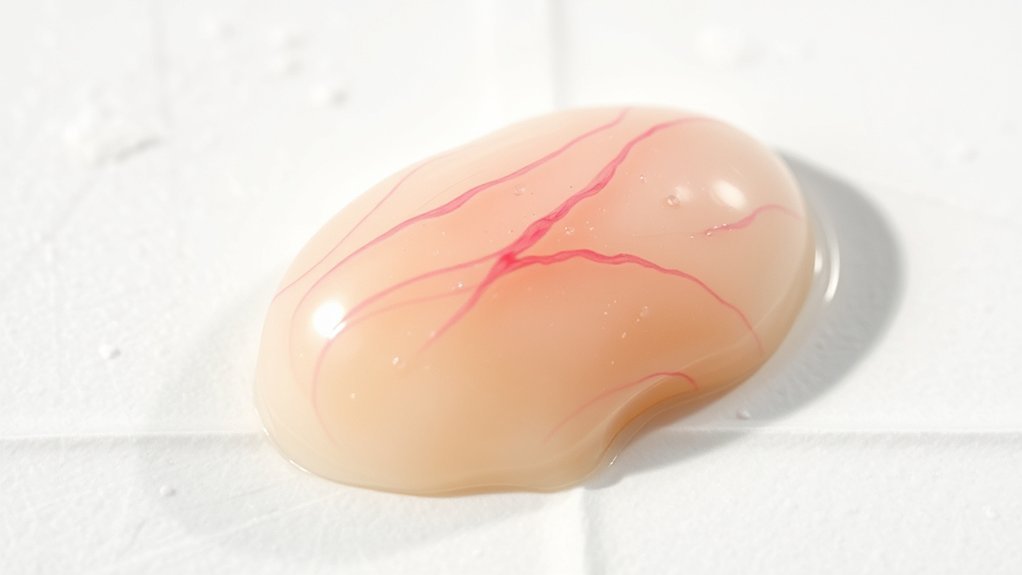During pregnancy, you may notice changes in your vaginal discharge as the mucus plug begins to dislodge. This thick barrier plays a vital role in protecting your baby, and its release can signal that labor is approaching. Understanding the signs and symptoms associated with this process is essential for your preparation. It’s important to know what to look for, as well as when to seek medical advice. What should you be aware of as you approach this significant milestone?
What Is the Mucus Plug?

The mucus plug is a thick, gel-like substance that forms in the cervix during pregnancy. Its primary function is to seal the cervical canal, providing a barrier against bacteria and other pathogens.
Composed of mucins, water, and various immune factors, the mucus plug changes in consistency and color throughout pregnancy. Initially, it may appear clear or slightly cloudy, but as you approach labor, it can become more tinged with blood or brownish. This change signals that your body is preparing for childbirth.
Typically, you mightn’t notice the mucus plug until it dislodges, which can occur days or weeks before labor begins. Understanding its characteristics helps you recognize signs of impending changes in your pregnancy.
The Role of the Mucus Plug in Pregnancy

Recognizing the mucus plug‘s role in pregnancy helps you understand its significance as a protective barrier. This gelatinous substance forms in the cervical canal, sealing the uterus and safeguarding the developing fetus from bacterial infections.
Throughout your pregnancy, the mucus plug thickens, adapting to hormonal changes and providing an essential defense mechanism. It also serves as an indicator of cervical changes, signaling that your body is preparing for labor.
When the time approaches, the plug may dislodge, which often signifies that you’re nearing delivery. Understanding this function allows you to monitor your pregnancy more effectively and recognize key milestones in your journey toward childbirth, emphasizing the mucus plug’s crucial role in maintaining a healthy gestation period.
Common Signs of Mucus Plug Discharge

Mucus plug discharge signals a significant change as you approach labor. You may notice several common signs indicating its release.
First, the discharge often appears thicker and may be clear, cloudy, or tinged with blood, resembling a gel-like consistency. You might experience an increase in vaginal wetness or a feeling of heaviness in your pelvic region.
Some women report mild cramping or contractions accompanying the discharge. It’s important to note that this discharge can occur days or weeks before labor begins, so staying alert to these signs is essential.
If you notice an unusual change in color or odor, or if you’re concerned about your symptoms, don’t hesitate to consult your healthcare provider for guidance.
Changes in Vaginal Discharge
As labor approaches, changes in vaginal discharge can occur alongside the release of the mucus plug.
It’s important to monitor these changes, as they can indicate your body’s preparation for labor. Here are some common changes you might notice:
- Increased Discharge: You may experience a noticeable increase in discharge volume.
- Color Changes: Discharge can shift from clear to a pink or brown tint, indicating cervical changes.
- Texture Alterations: You might observe a thicker, more mucous-like consistency.
- Odor Changes: A mild, earthy smell is normal, but a strong, foul odor could signal infection.
Stay aware of these signs as they can provide insight into your labor’s onset.
If you have concerns, consult your healthcare provider.
Cramping and Pelvic Pressure
Cramping sensations and pelvic pressure are common experiences as your body prepares for labor.
These symptoms can vary in intensity and timing, often signaling changes in your pregnancy.
Understanding what these sensations mean can help you better recognize when it’s important to seek medical attention.
Understanding Cramping Sensations
Understanding the sensations of cramping can be crucial during pregnancy, especially as the body prepares for labor. Cramping can indicate various physiological changes, so it’s essential to recognize their nature and implications.
Here are four key points to reflect on:
- Timing: Early cramping may differ from those experienced closer to labor.
- Intensity: Mild cramping can be normal, but severe or worsening cramps may require medical attention.
- Location: Cramping primarily in the lower abdomen is common, while back pain may suggest other issues.
- Accompanying Symptoms: If cramping is accompanied by bleeding or unusual discharge, contact your healthcare provider immediately.
Being aware of these factors can help you differentiate between typical sensations and potential concerns during your pregnancy journey.
Recognizing Pelvic Pressure
How can you identify pelvic pressure during pregnancy? You might experience a sensation of heaviness or fullness in your pelvic area.
This pressure can feel like a weight pressing down, often accompanied by cramping. You may notice that this sensation intensifies with prolonged standing or sitting.
It’s vital to distinguish this pressure from typical discomfort, as it can signal changes in your body as your pregnancy progresses.
Additionally, pelvic pressure can vary in intensity and may be more pronounced during certain activities, such as lifting objects or engaging in physical exercise.
If you’re unsure about your symptoms, it’s important to consult your healthcare provider to guarantee everything is progressing normally and to address any concerns you might have.
Timing of Symptoms
While many women experience cramping and pelvic pressure at various stages of pregnancy, the timing of these symptoms can provide important insights into your body’s changes.
Understanding when these symptoms occur can help you differentiate normal bodily adjustments from potential complications. Here’s what to reflect on:
- Early Pregnancy: Mild cramping can indicate implantation or hormonal changes.
- Mid-Pregnancy: Increased pressure may signal the stretching of the uterus.
- Late Pregnancy: Intense cramping could suggest the body preparing for labor.
- Post-Mucus Plug Loss: Cramping often intensifies as labor approaches, indicating cervical changes.
Pay attention to the timing and intensity of these symptoms, as they can help you communicate effectively with your healthcare provider.
When to Contact Your Healthcare Provider
You should contact your healthcare provider if you experience any abnormal symptoms, such as heavy bleeding, severe cramping, or unusual fluid discharge.
Timing is essential; seek medical help promptly to guarantee your safety and well-being.
Always err on the side of caution when it comes to your health.
Abnormal Symptoms to Watch
Recognizing when to reach out to your healthcare provider regarding mucus plug symptoms is essential for your well-being. Certain abnormal symptoms should prompt immediate communication with your healthcare professional.
Pay attention to the following signs:
- Severe abdominal pain: Intense discomfort may indicate complications.
- Heavy bleeding: If you notice significant blood loss, it’s important to seek help.
- Fever or chills: These may signal an infection that requires prompt evaluation.
- Persistent contractions: Regular contractions before the expected due date warrant medical advice.
Monitoring these symptoms closely can facilitate timely intervention and promote a healthy pregnancy.
Don’t hesitate to consult your healthcare provider if you have any concerns or questions about your condition.
Timing for Medical Help
Knowing when to contact your healthcare provider regarding mucus plug symptoms can greatly impact your health and pregnancy outcome. If you notice any abnormal discharge, such as a significant increase in mucus or a change in color, it’s crucial to reach out.
Additionally, if you experience any unusual symptoms like severe abdominal pain, heavy bleeding, or contractions before your due date, seek medical attention immediately. These signs may indicate complications.
Remember, it’s always better to err on the side of caution. Regular check-ins with your healthcare provider throughout your pregnancy help guarantee both your well-being and that of your baby.
Don’t hesitate to discuss any concerns you have about mucus plug changes or related symptoms. Your health is paramount.
Preparing for Labor and Delivery
As the due date approaches, preparing for labor and delivery becomes essential for expectant parents.
To guarantee a smooth process, consider the following steps:
- Pack a Hospital Bag: Include essentials like clothing, toiletries, and items for the baby.
- Create a Birth Plan: Outline your preferences for labor and delivery, including pain management and who’ll be present.
- Know Your Hospital’s Policies: Familiarize yourself with admission procedures, visitor policies, and any necessary paperwork.
- Arrange Transportation: Make sure you have reliable transportation to the hospital, and consider a backup plan.
Frequently Asked Questions
Can the Mucus Plug Regenerate After Being Discharged?
Yes, the mucus plug can regenerate after being discharged. Your body produces cervical mucus continuously, allowing for the potential formation of a new mucus plug, especially as you approach labor or during pregnancy changes.
Is It Normal to Lose the Mucus Plug Early?
Yes, it’s normal to lose the mucus plug early in pregnancy. Many women experience this without complications. However, if you notice significant changes or other symptoms, it’s best to consult your healthcare provider.
What Color Is the Mucus Plug Typically?
The mucus plug typically appears clear, white, or slightly pink. It may also have a yellow or brown tint. Variations in color can occur due to factors like hormonal changes or vaginal discharge throughout pregnancy.
Can I Still Have Intercourse After Losing My Mucus Plug?
Yes, you can still have intercourse after losing your mucus plug. However, it’s important to consult your healthcare provider to guarantee it’s safe, as your body may be approaching labor and certain precautions might be necessary.
Does Losing the Mucus Plug Guarantee Labor Will Start Soon?
Losing your mucus plug doesn’t guarantee labor will start soon. While it signals your body’s preparation, labor timing varies. Stay attentive to other signs and consult your healthcare provider for personalized guidance.
Conclusion
In conclusion, recognizing the signs of mucus plug discharge is essential as it indicates your body is preparing for labor. Remember, “an ounce of prevention is worth a pound of cure.” If you notice any unusual changes in your vaginal discharge or experience increased cramping and pelvic pressure, don’t hesitate to reach out to your healthcare provider. Staying informed and proactive guarantees both your well-being and that of your baby during this vital time.
